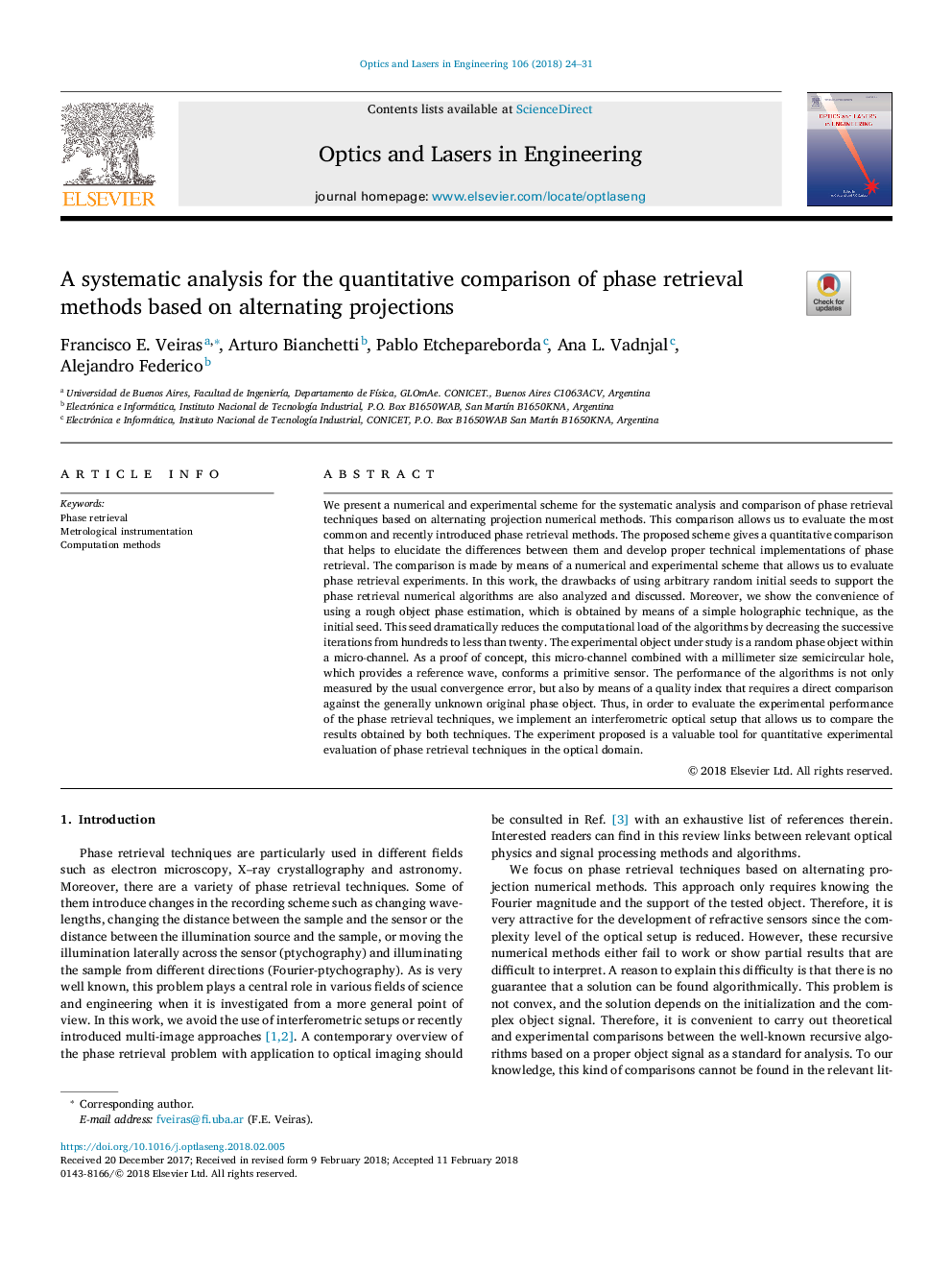| کد مقاله | کد نشریه | سال انتشار | مقاله انگلیسی | نسخه تمام متن |
|---|---|---|---|---|
| 7131591 | 1461687 | 2018 | 8 صفحه PDF | دانلود رایگان |
عنوان انگلیسی مقاله ISI
A systematic analysis for the quantitative comparison of phase retrieval methods based on alternating projections
ترجمه فارسی عنوان
تجزیه و تحلیل سیستماتیک برای مقایسه کمی از روش های بازیابی فاز بر اساس طرح های متناوب
دانلود مقاله + سفارش ترجمه
دانلود مقاله ISI انگلیسی
رایگان برای ایرانیان
کلمات کلیدی
بازیابی فاز، ابزار اندازه گیری، روش های محاسبه،
ترجمه چکیده
ما یک طرح عددی و آزمایشی برای تجزیه و تحلیل سیستماتیک و مقایسه تکنیک های بازیابی فاز مبتنی بر روش های عددی پیش بینی متناوب ارائه می دهیم. این مقایسه به ما امکان می دهد تا رایج ترین و جدیدترین روش های بازیابی فاز را ارزیابی کنیم. طرح پیشنهادی یک مقایسه کمی را ارائه می دهد که به توضیح تفاوت های بین آنها و ایجاد پیاده سازی فنی مناسب در بازیابی فاز کمک می کند. مقایسه با استفاده از طرح عددی و آزمایشگاهی انجام شده است که به ما اجازه میدهد تا آزمایشهای بازیابی فاز را ارزیابی کنیم. در این کار، اشکالات استفاده از دانه های تصادفی تصادفی برای حمایت از الگوریتم های عددی بازیابی فاز نیز مورد تجزیه و تحلیل قرار گرفته و مورد بحث قرار گرفته است. علاوه بر این، راحتی استفاده از برآورد فاز فیزیکی خشن را نشان می دهد، که با استفاده از تکنیک ساده هولوگرافی به عنوان دانه اولیه حاصل می شود. این بذر به طور چشمگیری باعث کاهش بار محاسباتی الگوریتم ها با کاهش تکرارهای پی در پی از صدها تا کمتر از بیست است. شئ آزمایشی مورد مطالعه یک شی فاز تصادفی در یک میکرو کانال است. به عنوان یک اثبات مفهوم، این میکرو کانال با یک سوراخ نیم سیمی اندازه میلیمتری، که یک موج مرجع را فراهم می کند، با یک سنسور اولیه روبرو است. عملکرد الگوریتم ها نه تنها با خطای همگرایی معمول اندازه گیری می شود، بلکه همچنین با استفاده از یک شاخص کیفیتی که نیاز به مقایسه مستقیم با شیء فاز اصلی به طور کلی ناشناخته است. بنابراین، به منظور ارزیابی عملکرد تجربی تکنیک های بازیابی فاز، ما یک تنظیم نوری بین فلوتریک را اجرا می کنیم که به ما امکان مقایسه نتایج حاصل از هر دو تکنیک را می دهد. آزمایش پیشنهادی یک ابزار ارزشمند برای ارزیابی تجربی کمی از تکنیک های بازیابی فاز در حوزه نوری است.
موضوعات مرتبط
مهندسی و علوم پایه
سایر رشته های مهندسی
مهندسی برق و الکترونیک
چکیده انگلیسی
We present a numerical and experimental scheme for the systematic analysis and comparison of phase retrieval techniques based on alternating projection numerical methods. This comparison allows us to evaluate the most common and recently introduced phase retrieval methods. The proposed scheme gives a quantitative comparison that helps to elucidate the differences between them and develop proper technical implementations of phase retrieval. The comparison is made by means of a numerical and experimental scheme that allows us to evaluate phase retrieval experiments. In this work, the drawbacks of using arbitrary random initial seeds to support the phase retrieval numerical algorithms are also analyzed and discussed. Moreover, we show the convenience of using a rough object phase estimation, which is obtained by means of a simple holographic technique, as the initial seed. This seed dramatically reduces the computational load of the algorithms by decreasing the successive iterations from hundreds to less than twenty. The experimental object under study is a random phase object within a micro-channel. As a proof of concept, this micro-channel combined with a millimeter size semicircular hole, which provides a reference wave, conforms a primitive sensor. The performance of the algorithms is not only measured by the usual convergence error, but also by means of a quality index that requires a direct comparison against the generally unknown original phase object. Thus, in order to evaluate the experimental performance of the phase retrieval techniques, we implement an interferometric optical setup that allows us to compare the results obtained by both techniques. The experiment proposed is a valuable tool for quantitative experimental evaluation of phase retrieval techniques in the optical domain.
ناشر
Database: Elsevier - ScienceDirect (ساینس دایرکت)
Journal: Optics and Lasers in Engineering - Volume 106, July 2018, Pages 24-31
Journal: Optics and Lasers in Engineering - Volume 106, July 2018, Pages 24-31
نویسندگان
Francisco E. Veiras, Arturo Bianchetti, Pablo Etchepareborda, Ana L. Vadnjal, Alejandro Federico,
